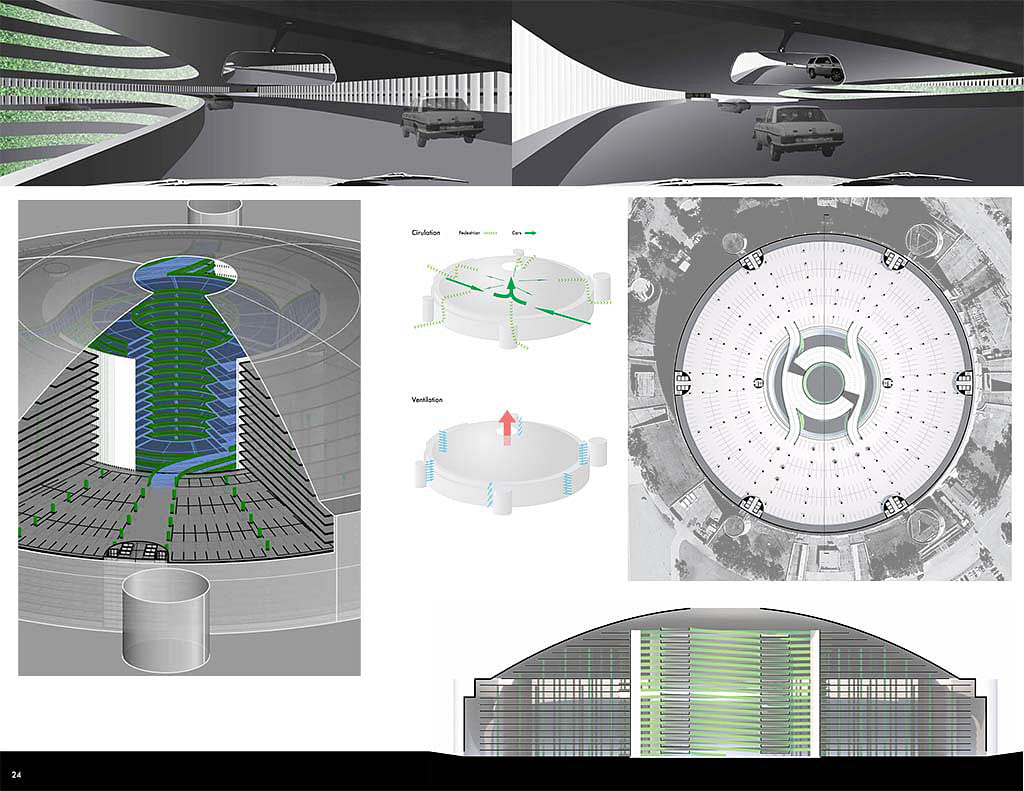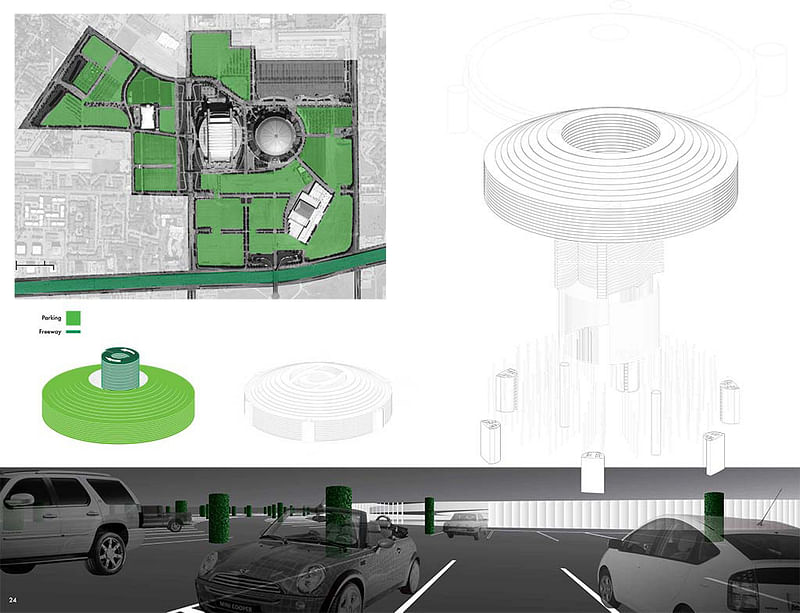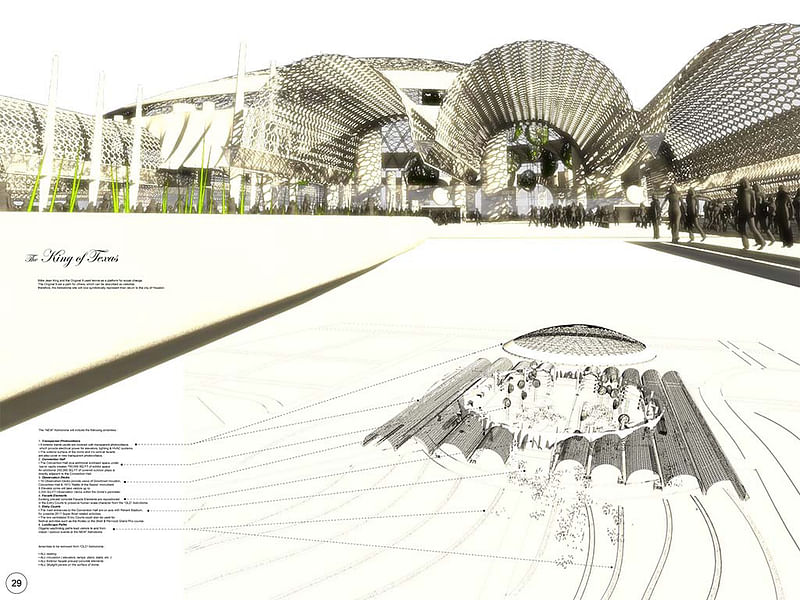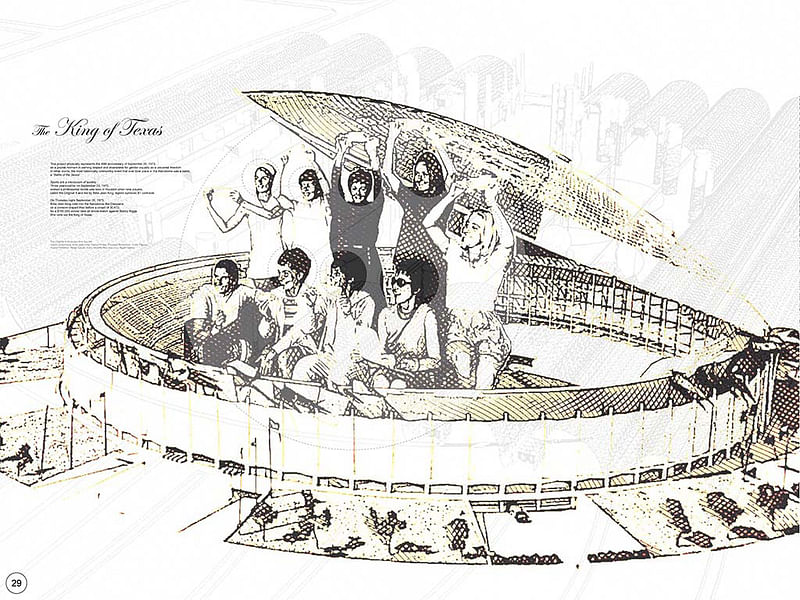Winners of the Reimagine the Astrodome ideas competition
By Bustler Editors|
Monday, Nov 11, 2013

Related
In a city where bigger is better, the endless possibitlies of what will happen to the Houston Astrome were to be expected in the Reimagine the Dome competition. Hosted by The Architect's Newspaper and YKK AP, entrants were limited to only their imaginations on determining how the aging Houston Astrodome will be repurposed.
The competition received 23 submissions whose concepts ranged from purely practical to creatively offbeat. The jury then selected four winners:
- 1st - AstroPark: Filling the Dome and Reclaiming Turf by David Richmond and Adam Wagner
- 2nd - The Houston Ark by HiWorks with Erica Goranson
- 3rd - The New Astrodome by Cruz Crawford and Elle Kuan
- 4th - The King of Texas by C_UP
The Jury featured:
- Sheryl Kolasinski, FAIA, deputy director of the Menil Collection
- Patricia Belton Oliver, FAIA, dean of Gerald D. Hines College of Architecture, University of Houston
- Robert M. Rogers, FAIA, principal at Rogers Partners
- Lawrence W. Speck, FAIA, principal at PageSoutherlandPage, professor at University of Texas School of Architecture, 2013 president of the Texas Society of Architects
- Bryan K. Trubey, AIA, principal/director at HKS Sports & Entertainment Group
- Sarah M. Whiting, Ph.D., principal at WW Architecture, dean and professor at Rice School of Architecture
1st place: AstroPark: Filling the Dome and Reclaiming Turf by David Richmond and Adam Wagner
"The Astrodome today exists as a functionless, yet iconic, architectural relic in Houston. While the interior used to provide a shared space for the city, the public now solely experiences the building’s exterior when passing to a football game, convention, or the rodeo in Reliant Park. This proposal inverts interior and exterior programs, bringing a large civil function back within the shell of the dome, preserving the iconic exterior and freeing up the surrounding landscape."

"Whether church, hospital, or shopping mall, Houston historically develops the world’s largest hubs for single programs. Along with the Texas Medical Center or Lakewood Church, which represent extremes in scale, the surface parking lot serving Reliant Park has become one of the world’s largest with spaces for 26,000 cars. This number will only grow if the Astrodome is destroyed. This proposal pulls the surrounding environment into the Astrodome, turning the structure into a 13,000-space garage, dramatically reducing the walk from car to stadium and creating a new shared experience for Houstonians.
As with the arena typology, the parking garage must move large amounts of people in and out rapidly and during fluctuating periods of use. To achieve this, two interlocking spiral ramps connecting 18 floors of parking are dropped into the empty center of the Astrodome, each wide enough to allow four lanes of traffic. In this central space, a kinetic experience on a grand scale flickers by as cars speed up and down the ramps, which are encompassed by a ring of vertical louvers that tease small views of the endless rows of parking. Astroturf clads the columns as well as the central ramps in tribute to the Astrodome’s optimistic past."
2nd place: The Houston Ark by HiWorks with Erica Goranson
"Although scientists had originally predicted it would take a century or more for the seas to rise as high as they did, in the end it all happened much sooner. By 2038, Galveston had been abandoned and the now submerged island was used as the base for the Ike Memorial Dike. Towering over Galveston’s original seawall built 130 years earlier, the new 45-foot-tall structure was intended to hold back the rising gulf. In the end it merely delayed the inevitable. In 2046, when storm waters from the relatively weak Tropical Storm Rick breached the trillion-dollar structure and surged up the Ship Channel, Houston knew it had only a few years left to prepare.

"Although no one remembered who first proposed the idea, it was a simple enough solution. A steel hull would be fabricated underneath the Astrodome so that when thewaters eventually came, the structure would simply float up and away. Stored securely inside the dome were the libraries of Rice and the University of Houston along with the collections of the MFAH and The Menil Collection as well as the specimens of the Museum of Natural Science and the Houston Zoo. The accumulated cultural resources of the once-great city were all moved into the old Harris County Domed Stadium to await the day when the waters came for Houston."

"150 years after the sea came for Galveston, it came for Houston. It was not a dramatic surge of a storm that moved the Houston Ark off its moorings. Instead it was the slow and incremental rise of the Gulf. The area around the Astrodome had been inundated for some time, returning the landscape to its native swamp environment. It was on a hot Tuesday morning in November of 2050 when the sensors indicated that the Ark had risen free of its original footings. The stabilizing thrusters were activated and the vessel set off on its journey.
It first sailed east, slowly making its way above what had been the I-10 corridor until it met up with both the New Orleans and St. Petersburg Arks, which had been anchored for years above Lake Charles. The three domes spent the next two weeks securing themselves to one another and synchronizing their control systems before sailing over the flooded State of Florida and turning north to meet up with the assembled Arks of the Eastern Seaboard."
3rd place: The New Astrodome by Cruz Crawford and Elle Kuan
"The New Astrodome seeks to establish a simulated reality—one of variable scale, speed, and matter—while at the same time reinvigorating the old astrodomain as a destination in Houston. The proposal embraces Houston's identity as Space City and is based on themes of outer space, earth, and how they relate to each other in physical space and space-time."

"The dome’s ceiling becomes a video surface, allowing for endless variations on the interior environment. From stargazing to swimming with whales, The New Astrodome is a glimpse into all scales of the universe, breaking the notion of a spatial constant."

"In addition, transparent torus fills the perimeter of the dome and is occupied by various programmatic uses, divided into four sections, which symbolize the Milky Way, solar system, earth, and Houston through the use of color and geometric representations. Shoppers, eaters, and the like move through these four sections, experiencing the spatial relationships between each."
4th place: The King of Texas by C_UP
"On Thursday night September 20, 1973, Billie Jean King rode into the Astrodome like Cleopatra on a crimson-draped litter before a crowd of 30,472, for a $100,000, winner-takes-all tennis match against Bobby Riggs. She rode out the King of Texas."

"Three years earlier on September 23, 1970, women’s professional tennis was born in Houston when nine players, called the Original 9 and led by Billie Jean King, signed symbolic $1 contracts."

"During the time-span of this competition, a very unique anniversary for the Astrodome (09.20.2013) passed without being adequately celebrated. This project physically represents the 40th anniversary of September 20, 1973 as a pivotal moment in earning respect and awareness for gender equality as a universal freedom.
Billie Jean King and the Original 9 used tennis as a platform for social change. The Original 9 set a path for others, which can be described as celestial. Therefore, the Astrodome site will now symbolically represent their return to the city of Houston."
For more info and jury comments on each winning submission, click here.
Images courtesy of The Architect's Newspaper.

Share
0 Comments
Comment as :